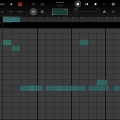Loopy Pro: Create music, your way.
What is Loopy Pro? — Loopy Pro is a powerful, flexible, and intuitive live looper, sampler, clip launcher and DAW for iPhone and iPad. At its core, it allows you to record and layer sounds in real-time to create complex musical arrangements. But it doesn’t stop there—Loopy Pro offers advanced tools to customize your workflow, build dynamic performance setups, and create a seamless connection between instruments, effects, and external gear.
Use it for live looping, sequencing, arranging, mixing, and much more. Whether you're a live performer, a producer, or just experimenting with sound, Loopy Pro helps you take control of your creative process.
Download on the App StoreLoopy Pro is your all-in-one musical toolkit. Try it for free today.
Whatever happened to MIDI 2.0?
I remember in 2019 and early 2020 that MIDI 2.0 would be coming out "soon" but it's been awhile. I still haven't seen anything more about it except that it's in Multitrack Studio per a Google search.
Anyone else know what's the latest on it?



Comments
Perhaps it is only a ghost/vapor spec
Hasn’t midi 2 been almost coming out for like 20 years now?
Not really needed imo, more hardware just needs to send/receive 14 bit midi over msb/lsb.
The official MIDI website posted some new stuff this article dated May 2021. That's only a few months ago.
https://www.midi.org/midi-articles/details-about-midi-2-0-midi-ci-profiles-and-property-exchange
MIDI 2.0 USB specs are still in progress
https://www.midi.org/midi/midi-articles/midi-2-0-progress-continues-with-updated-usb-specification
Roland announced a MIDI 2.0 controller
https://www.midi.org/midi-articles/roland-announces
It's sitting there inside your Mac, iPhone, iPad, Watch, and even Apple TV now. It's been there since iOS 14 and macOS 11. It's still going mostly unused though. I think that wider adoption won't happen until the MIDI Association finishes both the networking and USB versions of the transport spec. I personally think that it would have helped if they hadn't made it overly complex by keeping backwards compatibility with MIDI 1.
Ya but if it weren't backwards compatible it would never ever gain traction.
Yeah, you are probably right. Adoption is moving slowly enough even with the backwards compatibility.
I'd credit that more to MPE than anything else.
Because MPE handles most of what people want?
With Roli truly in the hands of the venture capitalists, and their Chief Tech Officer (Angus Hewlett, the man that set up FXpansion) having jumped ship to go to Image-Line as their head tech chap; one of the driving forces for getting MIDI 2.0 out of the gates has gone. (Roli was a central driving force because they popularised MPE - having burnt through countless millions in the process).
MIDI 2.0 is more than MPE, and MPE is bigger than Roli but their strategic shift will hurt MIDI 2.0.
MultitrackStudio supports both MPE and MIDI 2.0
I don't know about that. MIDI 2 handles a lot more.
What I meant is hardware manufacturers and developers took the time and trouble to provide MPE support. MIDI 2 represents a rework effort. @jonmoore 's post does a better job of communicating what I meant I think.
I see. Yeah, that makes sense too. MIDI 2 is definitely going to be more work than MPE was, but it has things that I'd really like to have so I'm impatient.
I read that MIDI 2.0 is supposed to eliminate latency, “jittering,” allow for more knob assignments than 8(?), and bi-something feedback (forgot the name but you can see feedback up and downstream essentially).
Posted by Craig Anderton on his forum:
https://juce.com/discover/stories/juce-6-1-released
New MIDI APIs on macOS 11 and iOS 14
JUCE now uses Apple's new MIDI APIs when running on the most recent Apple platforms. This development paves the way for broader MIDI 2.0 support across the JUCE framework as other platforms publish MIDI 2.0 APIs.
VST3 Plug-in Extensions
JUCE's VST3 backend has been redesigned, offering greater compatibility with the VST3 specification and enabling access to VST3-specific extensions. Plug-in developers can now access a much richer interface to any DAWs that provide their own set of extensions, such as those published by Presonus, Cockos and others.
Write up on first DAW (iOS and desktop) to implement MIDI 2.0 (alongside MPE) (MPE was already in place in this soft)
This report from March of this year
https://cdm.link/2021/03/midi-2-0-in-a-daw-multitrackstudio-adds-mpe-and-new-midi-standard/
I was wrong about the USB spec for MIDI 2.0. It's not in progress - it's already passed.
Presumably the Multitrack Studio dev waited until the USB spec passed, otherwise he may have some rework to do.
https://www.midi.org/midi/midi-articles/midi-2-0-progress-continues-with-updated-usb-specification
The latest Logic update 10.7 includes MIDI 2.0.
Unfortunately, I’m still running Logic on High Sierra (10.4.6) but now it’s a good reason to get a new Mac Mini or Pro 🙂
MPE: The MIDI mutilator! It's got electrolytes. It's got what musicians crave.
Any updates on this? I'm eager to test drive those 32-bit precision assignable CC modulators for when 127 steps isn't smooth enough.
afaik, the roland a-88 is the only device supporting 2.0
dunno how much good that does if there isnt a 2nd device supporting 2.0.....
The MPE companies should be leading this charge tho....